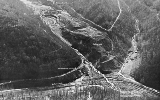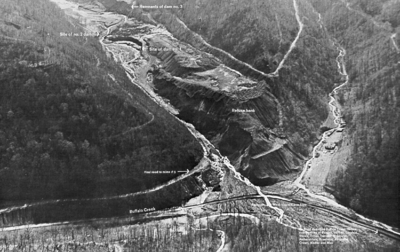
Buffalo Creek Flood
Encyclopedia

Dam
A dam is a barrier that impounds water or underground streams. Dams generally serve the primary purpose of retaining water, while other structures such as floodgates or levees are used to manage or prevent water flow into specific land regions. Hydropower and pumped-storage hydroelectricity are...
#3, located on a hillside in Logan County
Logan County, West Virginia
As of the census of 2000, there were 37,710 people, 14,880 households, and 10,936 families residing in the county. The population density was 83 people per square mile . There were 16,807 housing units at an average density of 37 per square mile...
, West Virginia
West Virginia
West Virginia is a state in the Appalachian and Southeastern regions of the United States, bordered by Virginia to the southeast, Kentucky to the southwest, Ohio to the northwest, Pennsylvania to the northeast and Maryland to the east...
, USA, burst four days after having been declared 'satisfactory' by a federal mine inspector.
The resulting flood unleashed approximately 132000000 gallons (499,674.4 m³) of black waste water, cresting over 30 ft high, upon the residents of 16 coal mining
Coal mining
The goal of coal mining is to obtain coal from the ground. Coal is valued for its energy content, and since the 1880s has been widely used to generate electricity. Steel and cement industries use coal as a fuel for extraction of iron from iron ore and for cement production. In the United States,...
hamlets in Buffalo Creek
Buffalo Creek (Guyandotte River)
Buffalo Creek is a tributary of the Guyandotte River, long, in southern West Virginia in the United States. Via the Guyandotte and Ohio rivers, it is part of the watershed of the Mississippi River, draining an area of in the Logan Coalfield. The creek was the site of the Buffalo Creek Flood in...
Hollow. Out of a population of 5,000 people, 125 were killed, 1,121 were injured, and over 4,000 were left homeless. 507 houses were destroyed, in addition to forty-four mobile homes and 30 businesses. The disaster also destroyed or damaged homes in Lundale, Saunders, Amherstdale, Crites, Latrobe and Larado. In its legal filings, Pittston Coal referred to the accident as "an Act of God."
Dam #3, constructed of coarse mining refuse dumped into the Middle Fork of Buffalo Creek starting in 1968, failed first, following heavy rains. The water from Dam #3 then overwhelmed Dams #2 and #1. Dam #3 had been built on top of coal slurry sediment that had collected behind dams # 1 and #2, instead of on solid bedrock. Dam #3 was approximately 260 feet above the town of Saunders when it failed.
Investigation
Two commissions investigated the disaster. One, the Governor's Ad Hoc Commission of Inquiry, appointed by Governor Arch A. Moore, Jr.Arch A. Moore, Jr.
Arch Alfred Moore, Jr. was the 28th and 30th Governor of West Virginia from 1969 until 1977 and from 1985 until 1989. He was a Congressman from 1957 until entering the governor's office. He is a member of the United States Republican Party. He ran for reelection in 1988, but was defeated by...
, was made up entirely of members sympathetic to the coal industry or government officials whose departments might be complicit in the genesis of the flood. After Arnold Miller, then president of the United Mine Workers
United Mine Workers
The United Mine Workers of America is a North American labor union best known for representing coal miners and coal technicians. Today, the Union also represents health care workers, truck drivers, manufacturing workers and public employees in the United States and Canada...
, and others were rebuffed by Gov. Moore regarding their request that a coal miner be added to the commission, a citizen's commission assembled to provide an independent review of the disaster. The Governor's Commission of Inquiry report http://www.marshall.edu/library/speccoll/virtual_museum/buffalo_creek/html/GAHCI-Report.pdf called for legislation and further inquiry by the local prosecutor. The report http://wvgazette.com/static/series/buffalocreek/Commission/commission.html by the Citizen's Commission concluded the Buffalo Creek-Pittston Coal Company was guilty of murdering at least 124 men, women and children. Additionally, the chair of the Citizen's Commission, Norman Williams, the Deputy Director of the West Virginia Department of Natural Resources, called publicly and in testimony before the legislature for the outlawing of coal strip mining throughout the state. He testified that strip mining could not exist as a profit making industry unless it is allowed by the state to pass on the costs of environmental damage to the private landowner or the public.
Results
Dennis Prince and some 625 survivors of the flood sued the Pittston Coal Company, seeking $64 million in damages ($ in 2011 dollars). They settled in June 1974 for $13.5 million, or approximately $13,000 for each individual after legal costs ($ each in 2011 dollars). A second suit was filed by 348 child survivors, who sought $225 million; they settled for $4.8 million in June 1974.The state of West Virginia
West Virginia
West Virginia is a state in the Appalachian and Southeastern regions of the United States, bordered by Virginia to the southeast, Kentucky to the southwest, Ohio to the northwest, Pennsylvania to the northeast and Maryland to the east...
also sued the company for $100 million for disaster and relief damages, but Governor Arch A. Moore, Jr.
Arch A. Moore, Jr.
Arch Alfred Moore, Jr. was the 28th and 30th Governor of West Virginia from 1969 until 1977 and from 1985 until 1989. He was a Congressman from 1957 until entering the governor's office. He is a member of the United States Republican Party. He ran for reelection in 1988, but was defeated by...
settled for just $1 million, three days before leaving office in 1977. The lawyers for the plaintiffs, Arnold & Porter
Arnold & Porter
Arnold & Porter LLP is a nine-office international law firm based in Washington, D.C. Arnold & Porter is well known for its trial, corporate, and antitrust work, and for its pro bono commitments and support for liberal causes.-History:...
of Washington, D.C., donated a portion of their legal fees for the construction of a new community center. West Virginia has yet to build the center, though it was promised by Governor Moore in May 1972.
Gerald M. Stern, an attorney with Arnold & Porter, wrote a book entitled The Buffalo Creek Disaster about representing the victims of the flood. It includes descriptions of his experiences dealing with the political and legal environment of West Virginia, where the influence of large coal mining corporations was intensely significant to the local culture and communities. Sociologist Kai T. Erikson
Kai T. Erikson
Kai Theodor Erikson is an American sociologist, noted as an authority on the social consequences of catastrophic events. He served as the 76th president of the American Sociological Association....
, son of distinguished psychologist and sociologist Erik Erikson
Erik Erikson
Erik Erikson was a Danish-German-American developmental psychologist and psychoanalyst known for his theory on social development of human beings. He may be most famous for coining the phrase identity crisis. His son, Kai T...
, was called as an expert witness and published a study on the effects of the disaster entitled Everything In Its Path: Destruction of Community in the Buffalo Creek Flood (1978). Erikson's book later won the Sorokin Award, granted by the American Sociological Association
American Sociological Association
The American Sociological Association , founded in 1905 as the American Sociological Society , is a non-profit organization dedicated to advancing the discipline and profession of sociology by serving sociologists in their work and promoting their contributions to serve society.The ASA holds its...
for an "outstanding contribution to the progress of sociology."
Simpson-Housley and De Man (1989) found that, 17 years later, the residents of Buffalo Creek scored higher on a measure of trait anxiety in comparison to the residents of Kopperston, a nearby mining town that did not experience the flood.
The Buffalo Creek disaster followed a similar coal waste impoundment failure in Aberfan, Wales on Oct 21, 1966, one that killed 144 people, including 116 schoolchildren between the ages of seven and ten.
Miscellaneous
On their 2001 release White Blood CellsWhite Blood Cells (album)
White Blood Cells is the third studio album by American alternative rock duo The White Stripes, released on July 3, 2001. Recorded in less than one week at Easley-McCain Recording in Memphis, Tennessee, and produced by frontman and guitarist Jack White, it was the band's final record released...
, The White Stripes
The White Stripes
The White Stripes was an American rock band, formed in 1997 in Detroit, Michigan. The group consisted of the songwriter Jack White and drummer Meg White . Jack and Meg White were previously married to each other, but are now divorced...
song "This Protector" alludes to the Buffalo Creek Disaster from the federal mine inspector point-of-view, through lyrics such as "300 people living out in West Virginia/have no idea of all these thoughts that lie within ya".
In the NCIS
NCIS (TV series)
NCIS, formerly known as NCIS: Naval Criminal Investigative Service, is an American police procedural drama television series revolving around a fictional team of special agents from the Naval Criminal Investigative Service, which conducts criminal investigations involving the U.S...
episode "Corporal Punishment", Dr. Mallard references the Buffalo Creek Disaster when discussing PTSD in a soldier returning from the Iraq War.
For their 2001 release "Barnstormin", James Reams & The Barnstormers (http://www.jamesreams.com) recorded a song "Buffalo Creek Flood" that tells the story from the point of view of the people in the coal mining towns that were destroyed by the flood.
See also
- 2006 Aracoma Alma Mine disasterAracoma Alma Mine accidentThe Aracoma Alma Mine accident occurred when a conveyor belt in the Aracoma Alma Mine No. 1 at Melville in Logan County, West Virginia caught fire...
- Coal slurry impoundment
- Martin County Sludge SpillMartin County sludge spillThe Martin County Sludge Spill was an accident that occurred after midnight on October 11, 2000 when the bottom of a coal sludge impoundment owned by Massey Energy in Martin County, Kentucky, USA, broke into an abandoned underground mine below. The slurry came out of the mine openings, sending an...
- SludgeSludge (film)Sludge is a 2005 documentary film by Appalshop filmmaker Robert Salyer chronicling the Martin County Sludge Spill that was an accident that occurred after midnight on October 11, 2000 when a coal sludge impoundment in Martin County, Kentucky, broke through an underground mine below, propelling 306...
- The Buffalo Creek Flood: An Act of ManThe Buffalo Creek Flood: An Act of ManThe Buffalo Creek Flood: An Act of Man is a 1975 documentary film produced by Appalshop. The film is about the Buffalo Creek Flood, an incident that occurred on February 26, 1972 when the Pittston Coal Company's coal slurry impoundment dam in Logan County, West Virginia burst four days after...

